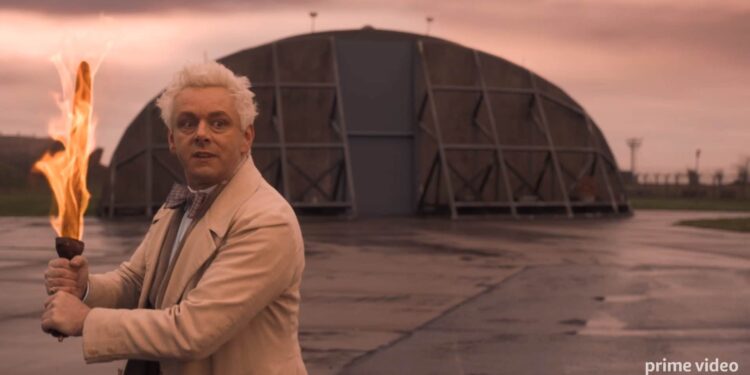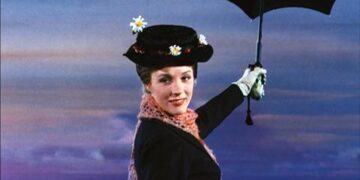Good Omens is a wildly popular novel and TV series that has captivated audiences around the world. Written by the dynamic duo of Terry Pratchett and Neil Gaiman, this comedic fantasy story tells the tale of an angel and a demon who must join forces to prevent the apocalypse. With its unique blend of humor, wit, and profound insights, Good Omens has become a beloved classic in the genre.
Brief Summary of the Book and TV Series
In both the book and TV series, Good Omens follows the misadventures of the demon Crowley and the angel Aziraphale, who have become quite fond of life on Earth and have formed an unlikely friendship over the centuries. When they learn that the Antichrist has been born and the end of the world is imminent, they set out to prevent the apocalypse from happening. Along the way, they encounter a cast of eccentric characters, including the Four Horsemen of the Apocalypse, and navigate a series of hilarious and dangerous situations.
Comparing the Detailed Book and TV Series Summary
While the overall plot of Good Omens remains consistent between the book and the TV series, there are some notable differences in the level of detail and the way certain events are depicted. The book, being a literary work, has the advantage of delving deeper into the thoughts and emotions of the characters. It provides rich descriptions of the settings and allows readers to fully immerse themselves in the story.
On the other hand, the TV series brings the world of Good Omens to life with its visual storytelling. It utilizes stunning cinematography, special effects, and a talented cast to recreate the vibrant and quirky universe envisioned by Pratchett and Gaiman. While some scenes and subplots are condensed or modified to fit the medium, the TV series successfully captures the essence of the book and adds its own visual flair.
Setting Timeline and Locations in Good Omens
Good Omens takes place in various locations and spans different time periods, creating a rich tapestry of settings for the story to unfold. From the Garden of Eden to modern-day London, the narrative weaves through time and space, offering a delightful blend of historical and contemporary elements.
The timeline of Good Omens is intricately constructed, with events taking place over thousands of years. It starts with the creation of the world and the Fall of Man, then jumps forward to key moments in human history, such as the crucifixion of Jesus and the Industrial Revolution. The story then centers around the present-day events leading up to the apocalypse.
Whether it’s the quaint streets of Tadfield or the grand landscapes of Heaven and Hell, the settings in Good Omens are carefully crafted to enhance the story’s whimsical atmosphere. Each location is imbued with its own unique charm and significance, providing a vivid backdrop for the adventures of Crowley and Aziraphale.
Who’s Who: Characters in Good Omens
Good Omens is filled with a colorful cast of characters, each with their own distinct personalities and quirks. The two central characters are Crowley, the demon who enjoys his hedonistic lifestyle on Earth, and Aziraphale, the angel who has developed a fondness for humanity and its earthly pleasures.
Other notable characters include Anathema Device, a descendant of the witch Agnes Nutter who possesses a rare book of prophecies; Newton Pulsifer, a bumbling but well-meaning young man who becomes entangled in the events leading to the apocalypse; and Shadwell, a belligerent and eccentric witchfinder.
The interactions between these characters, as well as their individual journeys and growth throughout the story, form the heart of Good Omens. Their unique personalities and dynamics contribute to the humor and charm of the narrative, making each character a memorable and beloved part of the Good Omens universe.
Guest Stars in the TV Series
One of the highlights of the Good Omens TV series is its star-studded cast, which features a number of talented actors in prominent roles. Michael Sheen delivers a brilliant performance as Aziraphale, capturing the angel’s endearing quirks and emotional depth. David Tennant shines as Crowley, bringing the demon to life with his charismatic and mischievous portrayal.
In addition to Sheen and Tennant, the series also features Jon Hamm as the charismatic Archangel Gabriel, Miranda Richardson as the delightfully eccentric Madame Tracy, and Frances McDormand as the voice of God. Each actor brings their own unique talents and charisma to their respective roles, further elevating the already captivating story of Good Omens.
Memorable Quotes from Good Omens
Good Omens is replete with memorable quotes that perfectly encapsulate the wit and wisdom of the story. From humorous one-liners to profound insights about human nature, these quotes have become beloved by fans and are often shared and referenced in various contexts.
Here are a few standout quotes from Good Omens:
- “It may help to understand human affairs to be clear that most of the great triumphs and tragedies of history are caused, not by people being fundamentally good or fundamentally bad, but by people being fundamentally people.” – Terry Pratchett and Neil Gaiman
- “We’ve got to learn from our mistakes. Otherwise, we’re what? Just animals.” – Aziraphale
- “Crowley had always known that he would be around when the world ended, because he was immortal and wouldn’t have any alternative. But he’d hoped it would be a long way off. Not just tonight.” – Terry Pratchett and Neil Gaiman
These quotes represent just a fraction of the witty and thought-provoking dialogue found in Good Omens. They highlight the unique blend of humor, philosophy, and social commentary that has made the story resonate with audiences.
Soundtrack by David Arnold
The soundtrack of Good Omens, composed by David Arnold, perfectly complements the whimsical and otherworldly atmosphere of the story. With its haunting melodies, energetic compositions, and playful motifs, the music adds an extra layer of depth and emotion to the narrative.
Arnold’s score combines elements of classical orchestration with contemporary sounds to create a soundtrack that is both timeless and modern. It captures the essence of the characters and their journeys, enhancing the viewing experience and immersing the audience in the world of Good Omens.
From the rousing theme that accompanies Crowley and Aziraphale’s escapades to the melancholic melodies that underscore moments of reflection and introspection, the soundtrack of Good Omens is a masterful work of art in its own right.
Tips for Cosplay and Dressing like Characters Crowley and Aziraphale
The characters of Crowley and Aziraphale have become iconic figures in popular culture, and many fans are inspired to dress up as these beloved characters for cosplay events and conventions. If you’re looking to embody the essence of Crowley or Aziraphale, here are some tips to help you nail the look:
- Crowley: To dress as the demon Crowley, embrace a punk aesthetic with a touch of elegance. Wear a sleek black suit with a red silk-lined trench coat and accessorize with sunglasses, a snake-shaped necklace, and a demonic smirk. Don’t forget to style your hair with a disheveled charm, and carry a snake prop for an extra touch of authenticity.
- Aziraphale: To channel the angelic Aziraphale, opt for a more classic and refined attire. Wear a tailored tweed suit with a crisp white shirt and a bowtie. Add a pair of round spectacles, a pocket watch, and a book prop to complete the scholarly look. Don’t forget to carry a thermos of tea, a symbol of Aziraphale’s love for earthly pleasures.
Remember, cosplay is all about having fun and expressing your love for a character. Feel free to add your own personal touches and interpretations to make the costume truly yours.
Terry Pratchett and Neil Gaiman: A Bio and Their 5 Best Works
Terry Pratchett and Neil Gaiman, the masterminds behind Good Omens, are both highly acclaimed authors in their own right. Let’s take a closer look at their backgrounds and explore their five best works:
Terry Pratchett
Terry Pratchett was a British author best known for his Discworld series, a sprawling collection of comedic fantasy novels set in a flat world balanced on the backs of four elephants standing on the shell of a giant turtle. Pratchett’s unique blend of humor, satire, and social commentary made him one of the most beloved and influential authors of his generation.
Here are five of Terry Pratchett’s best works:
- “Mort” (1987): This novel follows the story of Mort, a young man who becomes Death’s apprentice and must navigate the realm of the dead while grappling with his own mortality.
- “Guards! Guards!” (1989): In this book, Pratchett introduces the Ankh-Morpork City Watch, a dysfunctional group of law enforcement officers who must defend their city from a dragon and a plot to overthrow the Patrician.
- “Small Gods” (1992): “Small Gods” explores the nature of belief and religion through the story of Brutha, a novice in the Church of the Great God Om, who discovers that his god is not quite what he expected.
- “Night Watch” (2002): This novel follows the adventures of Commander Sam Vimes as he travels back in time and must prevent a revolution while facing his own personal demons.
- “Going Postal” (2004): In this book, con artist Moist von Lipwig is forced to take on the role of Postmaster in Ankh-Morpork and must navigate a corrupt system while restoring faith in the postal service.
Neil Gaiman
Neil Gaiman is a British author known for his works in the fantasy, horror, and graphic novel genres. His writing is characterized by its lyrical prose, dark whimsy, and exploration of myth and folklore. Gaiman’s stories have captivated readers with their vivid imagination and profound insights into the human condition.
Here are five of Neil Gaiman’s best works:
- “American Gods” (2001): This novel follows the story of Shadow Moon, a man who becomes caught in a war between ancient gods and new deities as they battle for power and influence in America.
- “Neverwhere” (1996): In this urban fantasy tale, Richard Mayhew stumbles into the hidden world of London Below and must navigate its treacherous and magical streets to save himself and those he cares about.
- “Coraline” (2002): “Coraline” is a dark fantasy novella about a young girl who discovers a parallel world that seems perfect at first glance but hides sinister secrets.
- “The Sandman” series (1989-1996): As one of Gaiman’s most iconic works, “The Sandman” combines elements of mythology, literature, and horror to weave a complex and captivating tale of Dream, the anthropomorphic personification of dreams.
- “Stardust” (1999): This enchanting fairy tale follows the adventures of Tristan Thorn as he ventures into the magical realm of Faerie to find a fallen star and win the heart of his true love.
These works represent just a fraction of the incredible literary contributions of Terry Pratchett and Neil Gaiman. Their unique storytelling styles and imaginative worlds continue to inspire and entertain readers of all ages.
Other Media by Neil Gaiman and John Finnemore
In addition to their written works, Neil Gaiman and John Finnemore have made significant contributions to other forms of media, including television, film, and radio. Here are five other noteworthy works by Gaiman and Finnemore:
- “Doctor Who” (2005-present): Neil Gaiman has written several episodes for the long-running British science fiction series “Doctor Who,” including the critically acclaimed episodes “The Doctor’s Wife” and “Nightmare in Silver.”
- “Coraline” (2009): Gaiman’s novella “Coraline” was adapted into a stop-motion animated film directed by Henry Selick. The film received widespread critical acclaim for its stunning visuals and faithful adaptation of the source material.
- “Neverwhere” (1996): Neil Gaiman’s novel “Neverwhere” was adapted into a television series in 1996. The series, also written by Gaiman, brought the fantastical world of London Below to life with its atmospheric storytelling.
- “Cabin Pressure” (2008-2014): Created by John Finnemore, “Cabin Pressure” is a radio sitcom that follows the misadventures of the eccentric crew of a single-plane charter airline. The series garnered a loyal following and received critical acclaim for its clever writing and hilarious performances.
- “Stardust” (2007): Neil Gaiman’s novel “Stardust” was adapted into a feature film starring Claire Danes and Charlie Cox. The film received positive reviews for its charming performances and whimsical storytelling.
These examples showcase the versatility and talent of both Neil Gaiman and John Finnemore in bringing their imaginative worlds to different mediums and captivating audiences across various forms of media.
Similar Movies and Books to Good Omens
If you’re a fan of Good Omens and are looking for similar movies and books that capture its unique blend of humor, fantasy, and wit, here are ten recommendations to satisfy your craving for more whimsical and thought-provoking storytelling:
- “Eternal Sunshine of the Spotless Mind” (2004): This film explores themes of memory, love, and identity in a quirky and inventive way, much like Good Omens.
- “The Hitchhiker’s Guide to the Galaxy” by Douglas Adams: This humorous sci-fi series follows the misadventures of Arthur Dent as he navigates the absurdities of the universe.
- “Dirk Gently’s Holistic Detective Agency” by Douglas Adams: Another creation by Douglas Adams, this series features a detective who solves crimes using an unconventional and interconnected approach.
- “The Princess Bride” (1987): This classic film combines humor, romance, and adventure in a fairy tale-like story that is both heartwarming and hilarious.
For those who enjoy a blend of fantasy and historical fiction, “Jonathan Strange & Mr Norrell” by Susanna Clarke is an excellent choice. Set in nineteenth-century England, this novel explores the world of two magicians and their quest to restore magic to its former glory.
Book club questions for Good Omens
If you’re part of a book club and have chosen Good Omens as your next reading selection, here are some thought-provoking questions to spark discussion:
- How does the collaboration between Neil Gaiman and Terry Pratchett influence the overall tone and style of the book?
- What elements of comedy and satire are present in Good Omens, and how do they contribute to the storytelling?
- Discuss the themes of free will and destiny in the book. How do the characters navigate these concepts?
- Explore the relationship between Crowley and Aziraphale. How does their friendship evolve throughout the story?
- How does Good Omens blend religious mythology with contemporary settings and characters? What effect does this have on the narrative?
Setting locations and travel guide for Good Omens fans
If you’re a dedicated fan of Good Omens and want to immerse yourself in the world of the story, here are some notable settings and travel destinations that you can visit:
- Tadfield: This picturesque village in Oxfordshire, England, serves as the primary setting for Good Omens. Explore the streets and visit St. Mary’s Church, which plays a significant role in the story.
- The M25: For a unique experience, take a drive along the M25 motorway, also known as the “London Orbital.” This iconic road is mentioned throughout the book and is a symbol of the eternal struggle between Heaven and Hell.
- Soho, London: This vibrant neighborhood is home to Aziraphale’s bookshop and Crowley’s favorite haunts. Take a stroll through the bustling streets and visit the real-life locations that inspired the book’s descriptions.
Parent guide for Good Omens
Good Omens is a delightful and witty story that can be enjoyed by readers of all ages. However, it does contain some mature themes and language that parents should be aware of when sharing the book or TV series with younger audiences.
The book explores topics such as religion, free will, and the nature of good and evil, which may provoke thought-provoking discussions with older children. It is always recommended for parents to read the book or watch the TV series beforehand to determine its appropriateness for their child’s age and maturity level.
While the TV series does contain some mild language and suggestive content, it is generally suitable for mature teenagers and older audiences. As a parent, it is important to engage in open conversations with your children about the themes and content of Good Omens to ensure they have a clear understanding and can appreciate the story in its intended context.
Curiosities and hidden gems in Good Omens
Good Omens is filled with delightful curiosities and hidden gems that add depth and intrigue to the story. Here are a few notable ones to keep an eye out for:
- Easter Eggs: Throughout the book and TV series, Neil Gaiman and Terry Pratchett have sprinkled numerous references to their other works. Keep an eye out for subtle nods and connections to further enhance your reading or viewing experience.
- Terry Pratchett’s Hat: In honor of Terry Pratchett, who passed away before the TV series was released, the production team placed his iconic hat on a park bench in one of the scenes. This touching tribute is a must-spot for fans of both Pratchett and Good Omens.
- Soundtrack by David Arnold: The TV series features a captivating soundtrack composed by David Arnold, known for his work on James Bond films. Listen closely to the music as it enhances the mood and atmosphere of the story.
Conclusion
In conclusion, the detailed book and TV series summary of Good Omens offers a rich and captivating experience for fans of Neil Gaiman, John Finnemore, and humorous fantasy storytelling. Whether you choose to delve into other works by these talented authors, explore similar movies and books, engage in book club discussions, visit setting locations, guide younger audiences as a parent, or discover hidden gems within the story, there is something for everyone to enjoy.
Good Omens invites readers and viewers into a world where angels, demons, prophecies, and humanity collide in a delightful blend of humor, adventure, and thought-provoking themes. So, grab a copy of the book, queue up the TV series, and embark on a journey that will leave you entertained, enlightened, and eagerly awaiting the next Neil Gaiman and John Finnemore creation.














